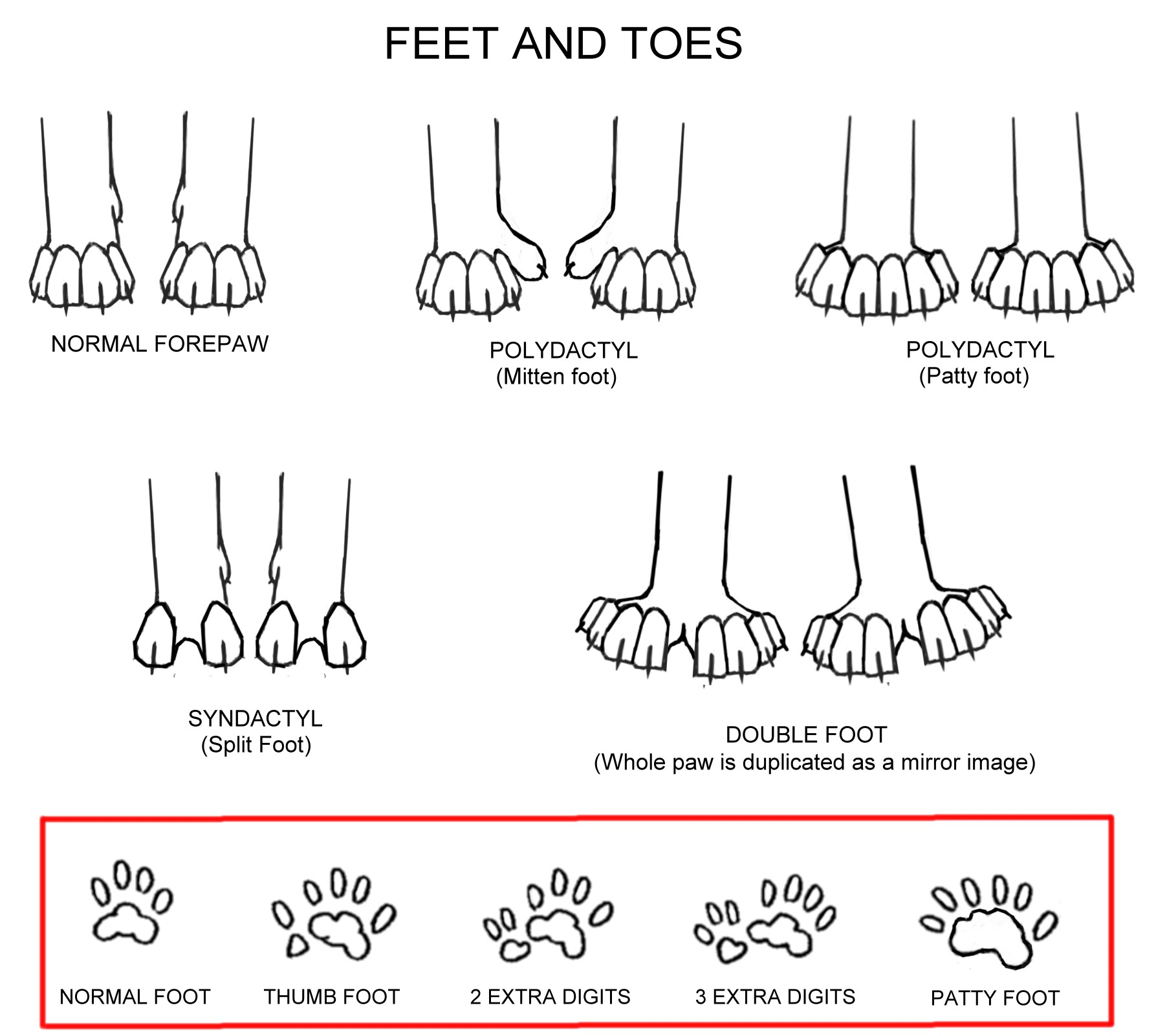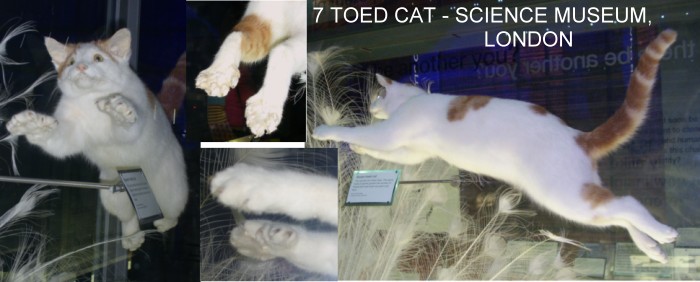
The greatest number of toes EVER found on a cat is 32 (eight on each paw) reported in October 1974. This was male cat called "Mickey Mouse" owned by Mrs Renee Delgade of Westlake Village, California, USA. It is possible he had a condition known as double-paws where each paw is actually 2 fused mirror image paws; this is a different condition to polydactyly. The condition is seen in humans where there is a central thumb with four fingers either side of it (making a natural baseball catcher's glove!). There have been reports of a cat where all 4 paws are doubled. When the cat "sat to attention" it had eight paws in a row. Double-paws is a developmental defect - during early development, the tip of the limb-buds fork to produce 2 mirror-image paws which may be set at right angles to each other.
A pure-bred Siamese named "Big Foot" owned by Miss Joan Conerly of Wauchula, Florida, USA in 1978, had 26 toes (seven on each front paw, six on each back paw). His mother had 22 toes, his sister had 22 toes and a brother had 24 toes.
A female cat named "Triple" owned by Mr and Mrs Bertram Bobnock of Iron River, Michigan, USA in 1976, had 30 toes, but these are arranged on 5 legs and 6 paws! The back left leg had 2 complete lower leg extensions from the hock down, and one of those lower legs had 2 paws. This is probably a developmental defect which caused the growing tip of the limb bud to split into two and each part of the fork continued to develop into a limb. It would have forked twice, once as it got to the hock and one side would have forked again when it began to grow the paw.
In May 2002 Jennifer Beierle wrote to me about a litter of kittens whose total of toes exceeds that of Big Foot and his litter-mates. Her non-polydactyl cat got pregnant by an unknown tomcat and produced 10 kittens. One was stillborn, 9 survived and seven were polydactyls. Two kittens had 26 toes (Peter and Paula,) two had 23 toes (Pollyanna and Penelope,) two with 22 (Phoebe and Peace,) one with 21 (Paprika,) and two with the normal 18 (Ace and Jean). Peter is double-pawed in front, with 7 toes on each front foot and six on the rear but no dewclaws at all. Paprika has a superclaw in front. Phoebe has the appearance of double-dewclaws on back, and Penelope has an under-developed toe with an ingrown nail.

In August 2002, the Canadian Press reported the case of a Manx cat that narrowly escaped death by euthanasia was a contender for the cat polydactyly Guinness world records. Bobbi has 28 toes, one more than the current record holder. Bobbi is owned by Kathy Williams of Stone Creek, near Prince George, British Columbia, Canada. She adopted Bobbi from the Prince George SPCA shelter where he was due to by put to sleep because of a heart condition (this turned out to be minor). His toe count must be authenticated by a vet before the record can be claimed.

Bobbi is not the first reported 28-toe cat, but he may be the first authenticated one. Saffy, owned by Joan Snoswell, was also reported to have 28 toes. Other cats with 28 toes are Patsy, a Maine Coon adopted from the Boston Animal Rescue League, and Bigfoot, owned by Tanya Welsch. Several others are reported on the internet including 28-toed Clyde from Albuquerque, New Mexico (below), whose details were emailed to me by his owner's sister who describes Clyde's oversized paws as resembling the feet of a snowshoe hare.

The current (i.e. verified) record holder (2002) is Tiger who has 27 toes. Tiger is owned by Gareth Ukrainetz of Leduc, Alberta, Canada and has seven toes on each front foot, and seven on her left hind foot, but only six toes on her right hind foot.

POLYDACTYLY AND NATURAL SELECTION
If polydactyls are common and not disadvantaged, why are there no polydactyl cat species or sub-species? There are, after all, localised polydactyl populations e.g. near Hemingway's home, some farm colonies.
Firstly there is the question of genetic isolation. For a distinct variety to be perpetuated, it must be genetically isolated from other cats. Farm colonies breed not only among themselves, but also mate with roaming feral tomcats and with other cats attracted into the colony. Unless the outsiders are polydactyls, this dilutes the genes. There are few cat populations isolated enough to give rise to a sub-species, let alone a species no longer able to interbreed with normal-toed cats. Recent artificial isolation of polydactyl cats (i.e. by establishing and controlling breeding lines) is giving rise to polydactyl breeds. An obvious case of an isolated population is the Manx cat from the Isle of Man. For genetic reasons (discussed later), though the tailless trait came to predominate (outnumber the fully tailed cats), it was never "fixed" i.e. it did not breed 100% true. Manx cats also produce non-Manx kittens.
It is suggested that the lack of a polydactyl sub-species means there is some sort of natural selection against the trait e.g. there may be hidden ill-effects or polydactyls are somehow at a disadvantage compared to normal-toed cats. This is the case in Manx cats where the gene can cause spinal abnormalities and pre-natal death. However, polydactyly is a "neutral" mutation - it is neither advantageous nor disadvantageous to the cat (tales of natural snowshoes notwithstanding). So why has it not become fixed in isolated populations?
The answer is in the mode of inheritance. Polydactyly in cats is due to a dominant gene mutation. This means that many polydactyls also carry the gene for normal toes. Polydactyl cats can produce normal-toed kittens so the trait is never "fixed" (true-breeding). In an isolated population, the trait could become common through inbreeding, but there will still be normal-toed cats because of the hidden recessive gene.
Even if there was some form of natural selection in favour of polydactyly and all normal-toed cats died before breeding age, the mode of inheritance means that the hidden recessive gene for normal toes is still present in the population. Non-poly kittens will still occur i.e. the cats do not breed true for polydactyly. Recessive genes are practically impossible to eradicate in a random-breeding population. In a breeding programme, a polydactyl would have to be test-mated to normal toed cats to see if the polydactyl carried the hidden recessive.
If, however, a recessive gene for polydactyly arose and for some reason the polydactyl cats had an advantage over normal-toed cat, this could give rise to a true-breeding polydactyl population, but only so long as they were isolated from other cats. In this case, polydactyly would not merely predominate, it would become fixed as the cats would be true-breeding.
Because recessive genes breed true, two normal-toed cats almost always produced only normal-toed kittens. "Almost always" because there is a very small chance of a fresh mutation or of one of the cats being genetically polydactyl but not showing the trait.
Since polydactyl cats sometimes use their "thumbs" to manipulate or grasp objects, why is the trait not actually advantageous? In spite of the potential usefulness of the opposable thumb, nature does not seem to select in favour of thumbed cats. The best explanation is that although cats have intelligence, it is not the sort of intelligence that makes an opposable thumb an evolutionary advantage over other cats, nor do they walk upright in order to keep their "hands" free for manipulating objects.
Polydactyly is an ancient trait and but for a quirk of evolution, all modern animals would have 7 or 8 digits instead of just 5. The oldest known four-legged animals, Ichthyostega and Acanthostega, had 7 or 8 digits per limb. The "extra" digits were next to the thumb. The extra digits disappeared 350 million years ago, leaving modern animals with just 5 per limb. 100 million years after evolution opted for five digits, throwbacks to ancestral polydactyly occurred, as a fossil of a seven-toed reptile demonstrates. The fossil, an aquatic marine reptile called Nanchangosaurus, was an mutant or evolutionary throwback which lived 100 million years after other seven-toed amphibians had died out.
Nanchangosaurus lived about 242 million years ago in China. The fossil reveals that it had seven complete digits on its forelimbs and six on its hind limbs. Other fossils didn't have well-preserved digits, so we can't be sure whether polydactyly was a trait of the whole species or if was restricted to a single mutant animals.
POLYDACTYLY IN HUMANS AND OTHER SPECIES: See Polydactyly in Humans and Other Species
GLOSSARY
- A dominant gene is one which shows up when only one copy of that gene is inherited- one for the mother OR one from the father.
- A recessive gene is one which only shows up if the cat inherits two copies of that gene - one from the mother AND one from the father.
- Heterozygous means that the two genes in a pair are different, the cat will not breed true for that trait as some of the offspring inherit the hidden recessive gene.
- Homozygous means that the two genes in a pair are identical and the cat will breed true for that trait.
- Autosomal means the gene is carried on an ordinary paired chromosome, not on the sex-linked X or Y chromosomes.
- Atavism (and atavistic) means the reappearance of an ancestral characteristic after several generations of absence; caused by chance mutation or by recombination of genes.
- Digit means finger or toe.
- A dewclaw is a vestigial (rudimentary) toe or claw which does not touch the ground, it sometimes resembles a thumb (pollex) which is smaller than the other toes.
- The phalanges are the bones inside the fingers and toes.
- Pre-axial means situated in front of the axis of a limb
- The radius is the long bone of the lower forelimb; in humans it is the forearm (elbow to wrist).
- The pollex (plural: pollices) is the thumb.
- The plantar pad is the heel pad of the paw.
- The palmar pad is the palm-pad of the paw.
- The apical cap is the tip of the limb-bud in a developing embryo.
Feline Medical Curiosisites - other anomalies in cats